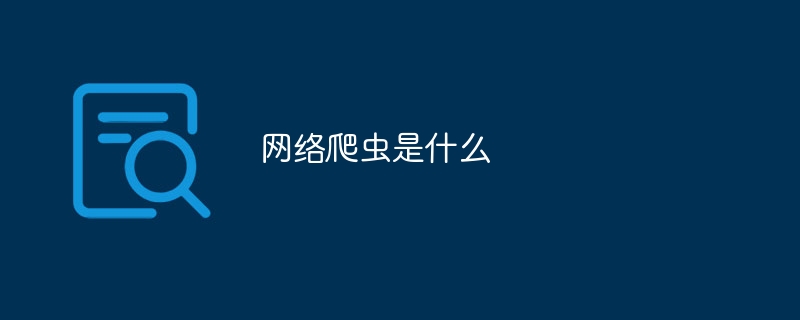
PHP study notes: web crawler and data collection
Introduction:
The web crawler is a tool that automatically crawls data from the Internet. It can simulate Human behavior, browsing the web and collecting the required data. As a popular server-side scripting language, PHP also plays an important role in the field of web crawlers and data collection. This article will explain how to write a web crawler using PHP and provide practical code examples.
1. Basic principles of web crawlers
The basic principles of web crawlers are to send HTTP requests, receive and parse the HTML or other data responded by the server, and then extract the required information. Its core steps include the following aspects:
- Send HTTP request: Use PHP's curl library or other HTTP library to send a GET or POST request to the target URL.
- Receive server response: Get the HTML or other data returned by the server and store it in a variable.
- Parse HTML: Use PHP's DOMDocument or other HTML parsing libraries to parse HTML to further extract the required information.
- Extract information: Extract the required data through HTML tags and attributes, using XPath or other methods.
- Storage data: Store the extracted data in a database, file or other data storage medium.
2. Development environment for PHP web crawler
Before we start writing web crawlers, we need to build a suitable development environment. The following are some necessary tools and components:
- PHP: Make sure PHP is installed and environment variables are configured.
- IDE: Choose a suitable integrated development environment (IDE), such as PHPStorm or VSCode.
- HTTP library: Choose an HTTP library suitable for web crawlers, such as Guzzle.
3. Sample code for writing PHP web crawler
The following will demonstrate how to use PHP to write a web crawler through a practical example.
Example: Crawl the titles and links of news websites
Suppose we want to crawl the titles and links of a news website. First, we need to get the HTML code of the web page. We can use the Guzzle library, its installation method is:
composer require guzzlehttp/guzzle
Then, import the Guzzle library in the code and send an HTTP request:
use GuzzleHttpClient;
$client = new Client();
$response = $client->request('GET', 'http://www.example.com');
$html = $response->getBody()->getContents();Next, we need to parse the HTML code and extract the title and Link. Here we use PHP's built-in DOMDocument library:
$dom = new DOMDocument();
$dom->loadHTML($html);
$xpath = new DOMXPath($dom);
$titles = $xpath->query('//h2'); // 根据标签进行提取
$links = $xpath->query('//a/@href'); // 根据属性进行提取
foreach ($titles as $title) {
echo $title->nodeValue;
}
foreach ($links as $link) {
echo $link->nodeValue;
}Finally, we can store the extracted titles and links into a database or file:
$pdo = new PDO('mysql:host=localhost;dbname=test', 'username', 'password');
foreach ($titles as $title) {
$stmt = $pdo->prepare("INSERT INTO news (title) VALUES (:title)");
$stmt->bindParam(':title', $title->nodeValue);
$stmt->execute();
}
foreach ($links as $link) {
file_put_contents('links.txt', $link->nodeValue . "
", FILE_APPEND);
}The above example demonstrates using PHP to write a simple A web crawler that crawls headlines and links from news websites and stores the data into databases and files.
Conclusion:
Web crawlers are a very useful technology that can help us automate the collection of data from the Internet. By using PHP to write web crawlers, we can flexibly control and customize the behavior of the crawler to achieve more efficient and accurate data collection. Learning web crawlers can not only improve our data processing capabilities, but also bring more possibilities to our project development. I hope the sample code in this article can help readers quickly get started with web crawler development.
The above is the detailed content of PHP study notes: web crawlers and data collection. For more information, please follow other related articles on the PHP Chinese website!
 使用Vue.js和Perl语言开发高效的网络爬虫和数据抓取工具Jul 31, 2023 pm 06:43 PM
使用Vue.js和Perl语言开发高效的网络爬虫和数据抓取工具Jul 31, 2023 pm 06:43 PM使用Vue.js和Perl语言开发高效的网络爬虫和数据抓取工具近年来,随着互联网的迅猛发展和数据的日益重要,网络爬虫和数据抓取工具的需求也越来越大。在这个背景下,结合Vue.js和Perl语言开发高效的网络爬虫和数据抓取工具是一种不错的选择。本文将介绍如何使用Vue.js和Perl语言开发这样一个工具,并附上相应的代码示例。一、Vue.js和Perl语言的介
 如何使用PHP编写一个简单的网络爬虫Jun 14, 2023 am 08:21 AM
如何使用PHP编写一个简单的网络爬虫Jun 14, 2023 am 08:21 AM网络爬虫是一种自动化程序,能够自动访问网站并抓取其中的信息。这种技术在如今的互联网世界中越来越常见,被广泛应用于数据挖掘、搜索引擎、社交媒体分析等领域。如果你想了解如何使用PHP编写简单的网络爬虫,本文将会为你提供基本的指导和建议。首先,需要了解一些基本的概念和技术。爬取目标在编写爬虫之前,需要选择爬取的目标。这可以是一个特定的网站、一个特定的网页、或整个互
 PHP 网络爬虫之 HTTP 请求方法详解Jun 17, 2023 am 11:53 AM
PHP 网络爬虫之 HTTP 请求方法详解Jun 17, 2023 am 11:53 AM随着互联网的发展,各种各样的数据变得越来越容易获取。而网络爬虫作为一种获取数据的工具,越来越受到人们的关注和重视。在网络爬虫中,HTTP请求是一个重要的环节,本文将详细介绍PHP网络爬虫中常见的HTTP请求方法。一、HTTP请求方法HTTP请求方法是指客户端向服务器发送请求时,所使用的请求方法。常见的HTTP请求方法有GET、POST、PU
 如何使用PHP和swoole进行大规模的网络爬虫开发?Jul 21, 2023 am 09:09 AM
如何使用PHP和swoole进行大规模的网络爬虫开发?Jul 21, 2023 am 09:09 AM如何使用PHP和swoole进行大规模的网络爬虫开发?引言:随着互联网的迅速发展,大数据已经成为当今社会的重要资源之一。为了获取这些宝贵的数据,网络爬虫应运而生。网络爬虫可以自动化地访问互联网上的各种网站,并从中提取所需的信息。在本文中,我们将探讨如何使用PHP和swoole扩展来开发高效的、大规模的网络爬虫。一、了解网络爬虫的基本原理网络爬虫的基本原理很简
 PHP 简单网络爬虫开发实例Jun 13, 2023 pm 06:54 PM
PHP 简单网络爬虫开发实例Jun 13, 2023 pm 06:54 PM随着互联网的迅速发展,数据已成为了当今信息时代最为重要的资源之一。而网络爬虫作为一种自动化获取和处理网络数据的技术,正越来越受到人们的关注和应用。本文将介绍如何使用PHP开发一个简单的网络爬虫,并实现自动化获取网络数据的功能。一、网络爬虫概述网络爬虫是一种自动化获取和处理网络资源的技术,其主要工作过程是模拟浏览器行为,自动访问指定的URL地址并提取所
 基于 PHP 的网络爬虫实现:从网页中提取关键信息Jun 13, 2023 pm 04:43 PM
基于 PHP 的网络爬虫实现:从网页中提取关键信息Jun 13, 2023 pm 04:43 PM随着互联网的迅猛发展,每天都有大量的信息在不同的网站上产生。这些信息包含了各种形式的数据,如文字、图片、视频等。对于那些需要对数据进行全面了解和分析的人来说,手动从互联网上收集数据是不现实的。为了解决这个问题,网络爬虫应运而生。网络爬虫是一种自动化程序,可以从互联网上抓取并提取特定信息。在本文中,我们将介绍如何使用PHP实现网络爬虫。一、网络爬虫的工作原
 OpenAI限制网络爬虫访问以保护数据免被用于AI模型训练Aug 15, 2023 pm 12:41 PM
OpenAI限制网络爬虫访问以保护数据免被用于AI模型训练Aug 15, 2023 pm 12:41 PM据报道,OpenAI最近推出了一个新功能,允许网站阻止其网络爬虫从其网站上抓取数据以训练GPT模型,以应对数据隐私和版权等问题GPTBot是OpenAI开发的网络爬虫程序,它能够自动搜索和提取互联网上的信息,并将网页内容保存下来,以供训练GPT模型使用根据OpenAI的博客文章,网站管理员可以通过在其网站的Robots.txt文件中禁止GPTBot访问,或者通过屏蔽其IP地址来阻止GPTBot从网站上抓取数据。OpenAI还指出,使用GPTBot用户代理抓取的网页可能会被用于改进未来的模型,同时


Hot AI Tools

Undresser.AI Undress
AI-powered app for creating realistic nude photos

AI Clothes Remover
Online AI tool for removing clothes from photos.

Undress AI Tool
Undress images for free

Clothoff.io
AI clothes remover

AI Hentai Generator
Generate AI Hentai for free.

Hot Article

Hot Tools

SublimeText3 Mac version
God-level code editing software (SublimeText3)

Dreamweaver CS6
Visual web development tools

ZendStudio 13.5.1 Mac
Powerful PHP integrated development environment

Safe Exam Browser
Safe Exam Browser is a secure browser environment for taking online exams securely. This software turns any computer into a secure workstation. It controls access to any utility and prevents students from using unauthorized resources.

PhpStorm Mac version
The latest (2018.2.1) professional PHP integrated development tool







